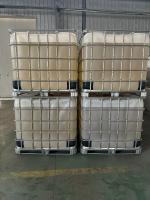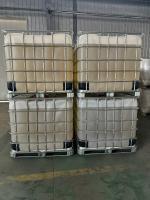Our Products
Product Center / polydadmac kemsep C-9011 can be replaced by Chinafloc -DADMAC

Polydiallyldimethylammonium chloride (polydadmac) is a cationic polymer with a wide range of industrial and environmental applications due to its unique chemical structure, which includes positively charged groups. These properties make it effective in flocculation, coagulation, antimicrobial activity, and other functions. Below are some of the most specific and common applications of polydadmac across various industries, with particular focus on its use in water treatment, paper production, textiles, oil and gas, and more.
1. Water Treatment and Wastewater Treatment
Polydadmac is widely used in water treatment, both for municipal and industrial wastewater. It is valued for its ability to coagulate and flocculate fine particles, suspended solids, and organic matter, improving the quality of the water for discharge or reuse.
a. Municipal Wastewater Treatment
In municipal wastewater treatment plants, polydadmac is primarily used as a coagulant to remove suspended solids, organic pollutants, and microorganisms. Its positive charge interacts with the negatively charged particles in the water, neutralizing their charges and forming larger aggregates (flocs) that can be easily removed through sedimentation or filtration. This is particularly useful in treating wastewater with high turbidity or fine colloidal particles that are difficult to remove through traditional methods.
b. Industrial Wastewater Treatment
Industries such as textiles, food processing, chemical manufacturing, and mining produce wastewater containing high levels of suspended solids, oils, dyes, and chemicals. Polydadmac is effective in coagulating and flocculating these contaminants, allowing them to be removed from the water. This results in treated effluent that meets regulatory standards and can be discharged safely into the environment or reused in industrial processes.
c. Drinking Water Treatment
Polydadmac is also used in the treatment of drinking water. It helps remove particulate matter, organic compounds, and pathogens from the water, ensuring it is safe for human consumption. Its flocculating properties improve the clarification process, making it especially effective in waters with high levels of organic matter, turbidity, or microbial contamination.
d. Sludge Dewatering
Polydadmac is employed in the dewatering of sludge generated during water and wastewater treatment. By enhancing the formation of larger flocs, polydadmac improves the efficiency of sludge removal and reduces the volume of water that needs to be removed. This is crucial in reducing sludge disposal costs and improving the overall efficiency of wastewater treatment processes.
2. Papermaking Industry
The papermaking industry benefits significantly from polydadmac, where it is used as a retention aid, strength enhancer, and wastewater treatment agent. Its cationic properties help improve various aspects of paper production, contributing to better paper quality and more efficient processes.
a. Retention and Formation Aid
Polydadmac is used as a retention aid in the paper manufacturing process. It improves the retention of fibers, fillers, and fines in the paper slurry, ensuring that these materials are not lost during the papermaking process. By increasing retention, polydadmac helps improve paper yield, reducing material waste and improving the overall efficiency of paper production.
b. Paper Strength Enhancement
In addition to aiding retention, polydadmac can be used as a strength additive. It enhances the bond between fibers, resulting in increased wet and dry strength of paper products. This is particularly useful in producing packaging materials, corrugated boards, and other types of paper that require improved strength for handling, transportation, and durability.
c. Wastewater Treatment in Papermills
Polydadmac is commonly used to treat wastewater generated during the papermaking process. Papermills produce wastewater that contains a significant amount of suspended solids, chemicals, and residual fiber. Polydadmac helps coagulate and flocculate these materials, facilitating their removal through sedimentation or filtration. This ensures that the effluent meets environmental standards and can be safely discharged or reused in the process.
d. Sludge Dewatering
Polydadmac is used in the dewatering of paper mill sludge. The polymer promotes the aggregation of solids, which results in larger, denser flocs that are easier to remove. This reduces the volume of water in the sludge, making disposal more cost-effective and environmentally sustainable.
3. Oil and Gas Industry
In the oil and gas sector, polydadmac is used primarily in drilling fluids, enhanced oil recovery (EOR), and wastewater treatment. Its ability to interact with negatively charged particles makes it valuable in improving drilling operations and managing oilfield wastewater.
a. Drilling Fluids
Polydadmac is added to drilling fluids to improve their performance. It helps to stabilize the drilling mud, increasing its viscosity and making it more effective in suspending cuttings and other solids during drilling operations. The addition of polydadmac can also help prevent the formation of mud cakes on wellbore walls, which can hinder the drilling process.
b. Enhanced Oil Recovery (EOR)
In EOR methods such as polymer flooding, polydadmac can be used to enhance the viscosity of the injection fluids. This improves the sweep efficiency of water flooding, resulting in better displacement of oil and higher recovery rates from mature reservoirs. Polydadmac also helps to reduce water production during EOR operations, leading to improved overall oil recovery.
c. Oilfield Wastewater Treatment
The oil and gas industry generates large quantities of wastewater, often containing emulsified oils, suspended solids, and other contaminants. Polydadmac is used to treat this produced water by coagulating and flocculating the contaminants, making it easier to remove them through filtration or sedimentation. The treated water can then be safely discharged or reused in the oil extraction process.
d. Corrosion Inhibition
Polydadmac has also been explored as a corrosion inhibitor in oil and gas operations. It helps protect metal surfaces in pipelines, tanks, and other equipment from corrosion caused by exposure to water, acids, and other corrosive agents. This extends the life of equipment and reduces maintenance costs in oilfield operations.
4. Textile Industry
Polydadmac is used in the textile industry for various functions, including dyeing, finishing, and wastewater treatment. Its ability to interact with textile fibers and dyes enhances the quality of fabric production and helps manage the environmental impact of textile manufacturing.
a. Dyeing and Printing
Polydadmac is often used as a mordant or fixative in textile dyeing and printing. It helps bind dyes more effectively to fabric fibers, improving the uniformity and colorfastness of the finished textile product. This ensures that the colors do not fade easily and that the dyeing process is more efficient.
b. Textile Wastewater Treatment
Textile manufacturing, particularly dyeing, generates large volumes of wastewater that contain dyes, chemicals, and suspended solids. Polydadmac is used to coagulate and flocculate these contaminants, making it easier to remove them from the water. This treatment process helps reduce the environmental impact of textile production and ensures that wastewater is safe for disposal or reuse.
c. Finishing and Coating
Polydadmac is sometimes used in textile finishing processes to improve the feel and appearance of fabrics. It can be used as a softening agent or to enhance the fabric’s resistance to wrinkles and shrinkage. By modifying the surface properties of textile fibers, polydadmac contributes to higher-quality finished products.
5. Cosmetic and Personal Care Products
Polydadmac is also used in cosmetics and personal care products, where it serves as a conditioning agent, emulsifier, and stabilizer. Its cationic charge helps it interact with negatively charged components in skin and hair, providing a smooth feel and improved texture.
a. Hair Care
In hair care products like shampoos, conditioners, and styling gels, polydadmac is used for its conditioning properties. It helps to smooth the hair cuticle, reducing frizz and static, and improving the overall manageability and shine of the hair. By forming a protective layer on the hair surface, it also helps to reduce damage caused by environmental factors, such as UV exposure and pollution.
b. Skin Care
In skin care, polydadmac is used as an emulsifying agent to help blend water and oil-based ingredients in creams, lotions, and serums. It stabilizes these formulations, ensuring that the product remains smooth and homogeneous. Additionally, its moisturizing properties make it beneficial in hydrating and softening the skin.
c. Antimicrobial Activity
Polydadmac also has antimicrobial properties, which make it useful in personal care products designed for skin or hair health. It can help inhibit the growth of bacteria and fungi, contributing to the preservation of the products and ensuring that they remain safe and effective during use.
6. Mining Industry
In the mining industry, polydadmac is used in mineral processing, flotation, and the treatment of mining wastewater. Its flocculating properties are beneficial for improving the efficiency of mineral extraction and managing the environmental impact of mining activities.
a. Mineral Processing
Polydadmac is used as a flocculant in mineral processing, particularly in the flotation process. It helps aggregate fine particles and improves the separation of valuable minerals from ore. By promoting the formation of larger flocs, polydadmac enhances the flotation efficiency, leading to higher recovery rates of desired minerals.
b. Wastewater Treatment in Mines
Mining operations generate wastewater that contains heavy metals, suspended solids, and chemicals used in mineral extraction. Polydadmac is employed to treat this wastewater by coagulating and flocculating the contaminants, allowing them to be removed through sedimentation or filtration. This treatment helps reduce the environmental footprint of mining operations and ensures compliance with environmental regulations.



230_small.jpg)

